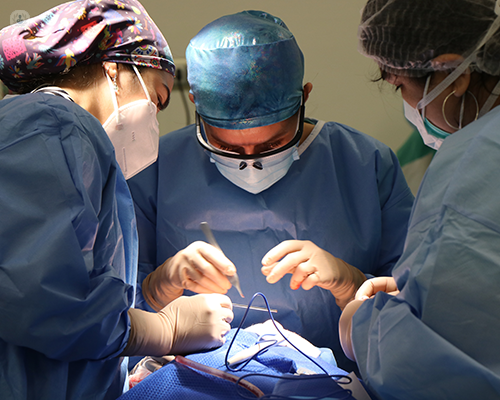What is the difference between off-pump and on-pump coronary artery bypass surgery?
Written in association with:If you have been diagnosed with coronary heart disease, your surgeon may recommend coronary artery bypass surgery (CABG), a procedure that involves grafting blood vessels to a healthy area in the coronary arteries to restore blood flow. The surgery can be performed using different techniques, including with an off-pump approach.
Here to provide an expert insight into off-pump coronary artery bypass surgery (OPCAB) is Mr Paul Modi, internationally-renowned consultant cardiothoracic surgeon with practice in Liverpool and Cheadle.

What is OPCAB used to treat?
OPCAB is a variant of coronary artery bypass surgery revascularisation to bypass blockages in the coronary arteries.
Broadly speaking, there are two ways to perform CABG.
The first option is the standard on-pump surgical approach. During the procedure, the surgeon stops the heart and puts the patient on a heart-lung machine (called a cardiopulmonary bypass) to redirect the blood out of the body. The blood circulates through the system of pipes, oxygenators, heaters and coolers in the cardiopulmonary bypass, and then reroutes back inside of the body. This process, which is repeated throughout the length of the operation, keeps the patient alive whilst the heart is surgically arrested and the surgeon is performing microsurgery grafting.
The second option is OPCAB, which is performed without the use of a cardiopulmonary bypass. During OPCAB, the heart is still beating whilst the surgeon performs microsurgery grafting on the heart. In some cases, a stabiliser may be used instead of a cardiopulmonary bypass to immobilise the 1-2cm section of the coronary artery that is being operated on. This offers several advantages, including the avoidance of the inflammatory response that is associated with cardiopulmonary bypass.
What is the difference between OPCAB and the standard on-pump surgical approach?
Clinical trial results vary with OPCAB and on-pump. Some results have shown no differences between the two or no benefit with OPCAB. Other results have shown superiorities, better neurological outcomes, or better renal kidney outcomes with OPCAB. Many different clinical trials have been carried out, and I think it is clear that if there are differences between the two approaches, they are small differences.
The choice of which approach to use is also an issue that splits all cardiac surgeons. Half of surgeons say that OPCAB is better because it avoids the deleterious effects of cardiopulmonary bypass that result from having blood whish through a system of tubes several hundreds of times. The other half say that on-pump is better because the heart is still and bloodless, allowing for an easier and a more delicate anastomosis (surgical connection) between the graft and the coronary artery.
Personally, my own preference is OPCAB when it is performed in the right hands with surgeons who are well-trained and who have performed hundreds of off-pump surgeries.
Is OPCAB an invasive procedure?
Yes, OPCAB is an invasive procedure because it involves a sternotomy, which is the division of the breastbone (sternum) to access the heart for surgery. A sternotomy takes two to three months to recover from.
Alternatively, robotic bypass off-pump surgery can be performed, which is a minimally invasive (keyhole) procedure. During this type of CABG, the surgeon makes a 4-5cm incision on the left side of the chest and then uses the Da Vinci robot to harvest the left internal mammary artery (in the chest). What internal mammary artery harvesting involves is the peeling down of the left internal mammary artery off the chest, leaving it attached to the subclavian artery, detaching it distally, and then swinging it backwards onto the heart.
We at Liverpool Heart and Chest Hospital are very lucky, because the hospital is the only centre in the UK providing robotic surgery right now. Robotic bypass surgery, especially, is a major part of our practice that is growing yearly.
The advantage of robotic bypass surgery is a much faster recovery; patients are home in three days and there is less post-operative pain involved because the nerves on the left chest wall are frozen or blocked with long-lasting local anaesthetic (Exparel). Overall, patients have a very comfortable post-operative course and are usually fully recovered three weeks after surgery.
The biggest disadvantage of robotic bypass surgery is that the technique can only be used to perform a single bypass graft, from the left internal mammary artery to the left anterior descending artery on the front of the heart. Arguably, though, this limited use of the technique is the best aspect about coronary surgery. The single graft has been shown to increase life expectancy, and I think that as the years go by, there will be an upsurge in the number of single bypass grafts being performed.
In addition, robotic bypass surgery can be supported with the use of the latest generation of drug-eluting stents for blood vessels.
Thus, the best of both worlds is achieved; the non-invasiveness of robotic bypass surgery with the durability of the left mammary artery graft, and, the increase in life expectancy that the left mammary artery graft confers. As well as this, another benefit to consider is the non-invasiveness of stenting in the coronary target which occurs in robotic hybrid procedures. I think that we are going to see a big, big growth in the number of these procedures being performed in the coming years.
What is the recovery period like after OPCAB?
The recovery period depends on the approach used.
If a sternotomy approach is used and a multiple vessels multi-arterial OPCAB is performed, then the recovery period is essentially the same as on-pump coronary artery bypass surgery. This is because the speed of recovery is usually dictated by the sternotomy, which involves two to three months of recovery time. At the moment, there is no strong evidence that says that OPCAB patients recover faster than on-pump.
If a robotic OPCAB revascularisation is performed using a 4-5cm incision on the left side of the chest, then the recovery period is much faster. In most cases, this includes three days in hospital and a return to normal activities three weeks after surgery.
Does OPCAB have a high success rate?
The success rate is very high. In terms of operative risk, almost all patients can be completely artery revascularised through a sternotomy, and the risk of the operation is low.
Despite this, clearly there are various factors that define operative risk. Many of these risks are related to the patient and how fit the patient is coming into surgery, but many others are also related to the type of operation that is being performed (whether it is only OPCAB or whether valve surgery is needed as well). Usually, standard operative risk for elective coronary surgery is between one to two per cent, which is very low.
Mr Paul Modi is a renowned consultant cardiac surgeon with more than 25 years of experience.
If you require OPCAB and wish to consult your options with an expert, do not hesitate to visit Mr Modi’s Top Doctors profile today.


